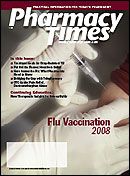How to Reduce Harm from Opiates
Suggested strategies are presented to help avoid medication errors and subsequent harm with opiates. Errors resulting from these high-alert medications can cause allergic reactions, seizures, and even death.
Dr. Gaunt is a medication safety analystand the editor of ISMP MedicationSafety Alert! Community/AmbulatoryCare Edition.
Morphine (an opiate) wasamong 6 medications on thefirst list of high-alert medicationspublished by the Institute for SafeMedication Practices (ISMP) in 1989.1High-alert medications are drugs thatbear a heightened risk of causing significantpatient harm when they are usedin error. Although mistakes in prescribing,dispensing, and administering thesemedications may or may not be morecommon with these drugs, the consequencesof an error can be more devastatingto patients. ISMP has receivednumerous reports of patient harm dueto medication errors involving opiates,including the misuse of the fentanyltransdermal system, confusion betweenparegoric and tincture of opium, andmix-ups of oxycodone extended- andimmediate-release formulations.
Subscribe to Newsletter
Contact ISMP at 215-947-7797, or send an
e-mail message to
linkEmail('community','ismp.org');
.
Aside from abuse of opiates, errorshave led to serious adverse events,including allergic reactions, failure tocontrol pain, oversedation, respiratorydepression, seizures, and death. Errorscan be made at all phases of the medication-use process, such as the prescribing,prescription intake, dispensing,or patient administration phases.Suggested safeguards are listed in theTable. Although advanced technologiessuch as electronic prescribing, pharmacycomputer systems with advanceddecision support, and bar coding areincluded, the focus is on drug-specificinterventions that can be incorporatedinto your practice.
Table 1
Suggested Safeguards for Preventing Medication Errors
- Avoid the use of meperidine for pain control,especially in elderly and renal-compromisedpatients
- Eliminate tincture of opium from communitypharmacy inventory if possible. If it must bestocked, segregate and/or secure tincture ofopium in a separate area to avoid confusionwith paregoric.
- When appropriate, consider nonopiate medicationsand nonpharmacologic therapies forpain
- For electronic prescribing systems, listonly the most frequently used medications,strengths, and doses
- Eliminate error-prone abbreviations from preprintedprescriptions and electronic prescribingsystems
- Separate morphine and hydromorphone, concentratedand conventional oral liquid opiates,and extended- and immediate-release formulationsof oxycodone in storage, dispensing,and administration areas
Improve Access to Information
- Use "paregoric," the official name of camphoratedopium tincture in the United States,on prescriptions, inventory lists (includingcomputer systems), and labels
- Ensure that oxycodone prescriptions clearlyspecify the dosage form (eg, extended orimmediate release)
- Provide equianalgesic charts for differentopiate products for prescribers, nurses, andpharmacists
- In long-term care facilities, require documentationof patch application (including location)and removal on nursing medication administrationrecords (MARs). Consider including anorder to check the placement and location ofthe patch each day or each shift.
- Establish dose ranges by weight, and builddose alerts into electronic prescribing systemsand pharmacy systems
Simplify and Standardize
- Prescribers should establish protocols forpain management, depending on the severityof pain
- In long-term care facilities and hospiceprograms, establish protocols for pain management,including a standard pain scale forassessment and reassessment, guidelinesfor the use of specific analgesics, conditionsrequiring a dose reduction, and requirementsfor monitoring
- Reduce the variety of opiates and other analgesicsin electronic prescribing systems tothose used most frequently
- Prescribe and dispense liquid medicationswith the dose specified in milligrams, neverin volume
- Never use error-prone abbreviations andsymbols, such as DTO, MS, trailing zeros, ornaked decimals
Differentiate
- Use tall-man lettering for HYDROmorphoneon labels, preprinted prescriptions, MARs,patient profiles, and drug listings on computerscreens
- Apply auxiliary warning labels to areaswhere opiates are stored and directly toproducts that look similar to help differentiatethem, when appropriate
Use Reminders
- Apply warning labels to concentrated formsof morphine and opium tincture and build incomputer screen alerts to remind staff abouttheir concentrations
Employ Redundancies
- Incorporate prompts in electronic prescribingand pharmacy computer systems to verifypast opiate use for patients prescribed afentanyl transdermal patch greater than 25mcg/hr, concentrated morphine solutions, orlong-acting opiate products
- Routinely compare narcotic prescriptionswith narcotic sign-out records to ensureerrors are not being made
Educate Patients
- Provide direct patient counseling to allpatients and/or their caregivers receivingopiate products
- Provide guidelines to patients and caregiversfor appropriate monitoring of patients whoare receiving opiates. Include informationabout contacting their prescriber regardinguncontrolled pain prior to taking more of thesame or different pain control medications(eg, adding OTC medications).
- Instruct patients who use fentanyl patchesto apply them properly, avoid heat exposure,and store and dispose of the patches in asecure manner to avoid unintended accessby children, pets, or drug-seeking individuals.Include directions on how to set up a dosingcalendar that includes where a patch isapplied and when it should be removed.
- Advise patients to swallow oral extendedreleaseformulations whole. Apply warninglabels to not crush or chew extended-releaseformulations to prescription vials.
References
- Davis NM, Cohen MR. Today's poisons—how to keep them from killing your patients. Nursing. 1989;19(1):49-51.

